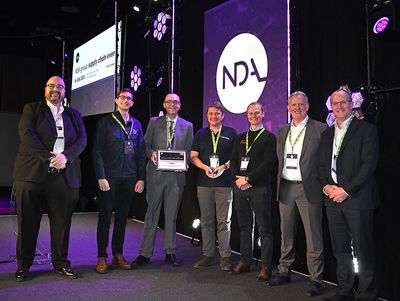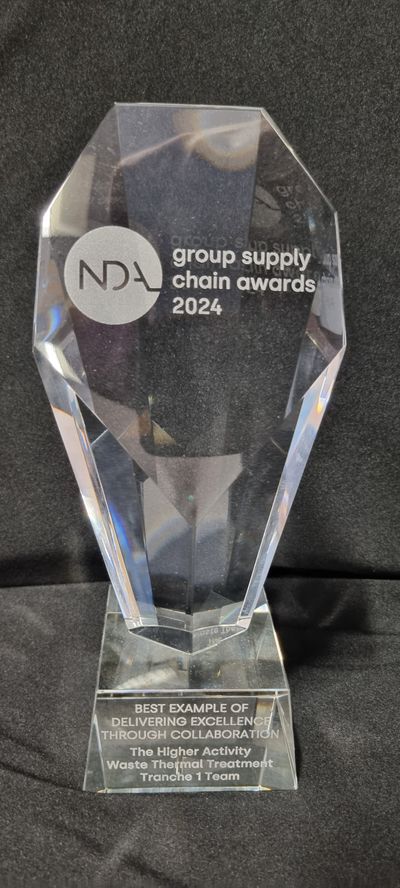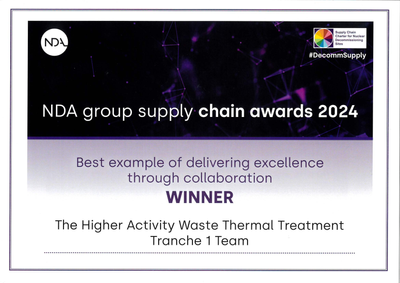Plasma Technology Consortium Wins NDA Award for Nuclear Waste Treatment
Published:
Read Time: 5 mins
Plasma Technology Consortium Wins NDA Award for Nuclear Waste Treatment
Tetronics seen as a key thermal treatment solution following senior stakeholder visits
22 January 2025: Tetronics, a world leader in plasma arc systems for waste treatment, materials recovery, industrial decarbonisation and green hydrogen production, has received an award from the UK Nuclear Decommissioning Authority (NDA) for its key role in successful Higher Active Waste Thermal Treatment (HAWTT) trials.
The HAWTT programme is led by Sellafield Limited, sponsored and directly funded by both the NDA and Nuclear Waste Services (NWS). Under its contract with Sellafield, Tetronics has designed, developed and manufactured a plasma arc rig to stabilise, vitrify and significantly reduce the volume of higher active waste from the nuclear sector. This exclusive contract falls into tranche 1 of the HAWTT programme, which is focussed primarily on solid, Plutonium Contaminated Materials (PCM).
As part of the HAWTT tranche 1 work, Tetronics collaborated with a range of world class engineering partners on nuclear safety, engineering management, trial planning and execution, integration of key supporting plant and project management,. This consortium includes Cavendish Nuclear Limited, Red Engineering, National Nuclear Laboratories, Cerberus and AtkinsRealis. Together, they won the “best example of delivering excellence through collaboration” award at the NDA’s annual supply chain event on 16th January 2025.
Graeme Rumbol, Chief Executive of Tetronics, said: “I am immensely proud to share in the NDA’s excellence in collaboration award and would like to thank both Tetronics’ own team and our consortium partners for such positive HAWTT trial results. Combined with strong feedback from the six government agencies who visited our Swindon facility in 2024, we believe that large scale thermal treatment, including plasma, is ideally placed for the NDA’s upcoming case for change white paper.”
Many higher active wastes – ranging from contaminated construction materials and clothing to consumables and packaging – have traditionally been “treated” by physical compaction alone, followed by encapsulation in a cement-based grout within 200-litre drums.
Tetronics’ technology both reduces the volume and enhances the stability of radioactive waste before final geological disposal. Assessments indicate that the likely lifetime cost savings of using plasma vitrification to stabilise radioactive materials amounts to billions of dollars globally. More specifically, Tetronics believes that such volume reduction will help to meet the UK Nuclear Sector Deal’s target for a 20% decrease in decommissioning costs by 2030.
The HAWTT Tranche 1 trials were delivered in three phases throughout 2024:
· Trial 1 – process validation, based on surrogate wastes including clothing, rags, consumables and small components;
· Trial 2 – process optimisation, focussed on increasing waste throughput and achieving optimal layering within the vitrified (glass-like) end product;
· Trial 3 – final product, melting thirty-seven 200 litre drums of analogous waste (containing a Cerium marker) into a crucible container to fit inside a 3m3 box.
In July and December 2024 Tetronics, along with key consortium partners, hosted high level representatives from six nuclear stakeholders at its full-scale prototype rig in Swindon, UK:
· Nuclear Decommissioning Authority
· Nuclear Restoration Services
· Office for Nuclear Regulation
· Nuclear Security Technologies
Stakeholder feedback has been overwhelmingly positive and has already led to a further contract, from Sellafield, for a fourth phase trialling items larger than 200 litre drums to demonstrate large scale thermal capability.
Andrew Jarratt, Head of Projects at the HAWTT programme, added: “The project has brought together an array of different companies from all over the UK to deliver the first step in a potentially game-changing technology for the treatment of plutonium contaminated wastes in the UK. This was done in a remarkably short time and with a tight budget. The team have faced significant challenges and it is testament to the collaborative working practices and team ethos that these have been overcome and the trials programme successfully initiated.”
Longer term, Tetronics has agreed to keep the rig available for additional trials over the next two years, further strengthening the case for the inclusion of large scale thermal treatment, including plasma, in the NDA’s strategic case for change white paper.
Graeme concludes: “Tetronics looks forward to playing a key role in the global renaissance of nuclear energy as a secure, predictable and low carbon baseload for increasingly renewable-reliant grids. That includes here in the UK, buoyed by Great British Energy’s recently announced £3.8 billion fund for Small Modular Reactors.”
ENDS
Ends
Editors notes
Notes to editors
Images from the NDA awards ceremony are available to download [here].
Caption for consortium photo, from left to right:
David Connolly Nuclear Waste Services; Tim Pons, Atkins Realis; Sean Clarke, National Nuclear Laboratories; Tom Page, Cerberus; Will Hopps, Red Engineering; John Conway, Tetonics; Leigh Wakefield, Cavendish Nuclear.
For further media information, or to arrange a briefing, please contact:
Justin Heath or Rhiannon Day
Resonates
Mbl. +44 7760 263269
Commercial contact:
Graeme Rumbol
Chief Executive
Tetronics Technologies Limited
Wk: +44 1793 379229
About Tetronics
Tetronics is the most experienced plasma company in the world. It is founded on five decades of R&D and 128 patents (granted and pending), with over 20 years of operational expertise, across 100 global technology reference sites. The majority of these existing applications are in waste minimisation and resource recovery from challenging waste streams, including automotive or industrial catalysts, and decarbonisation of heat intensive manufacturing processes – such as steel, glass and cement. World class clients include Harsco, Hitachi-Zosen, Mitsubishi, Nippon Steel and Outokumpu.
Tetronics’ resource recovery process generates an inert, robust and fully vitrified by-product, Plasmarok®, that has a wide range of commercial applications, particularly in construction.
Tetronics’ capabilities encompass everything from initial modelling/feasibility assessment, testing of process material at its own pilot facilities, through to design, supply, site installation/commissioning and ongoing support of full commercial plants.
Tetronics’ is actively helping its multi-national clients meet the Net Zero agenda and the company has a strong pipeline of future projects in: CO2 reduction; green hydrogen supply; alternative fuels; process electrification; energy and critical mineral security.
About Sellafield
Sellafield Ltd is an organisation focused on creating a clean and safe environment for future generations. It operates the Sellafield Nuclear Licensed Site on behalf of the Nuclear Decommissioning Authority (NDA). From cleaning-up the country’s highest nuclear risks and hazards to safeguarding nuclear fuel, materials and waste, its work is nationally important.
It is the only organisation in the UK which can safely manage all three forms of nuclear waste: high, intermediate and low.



